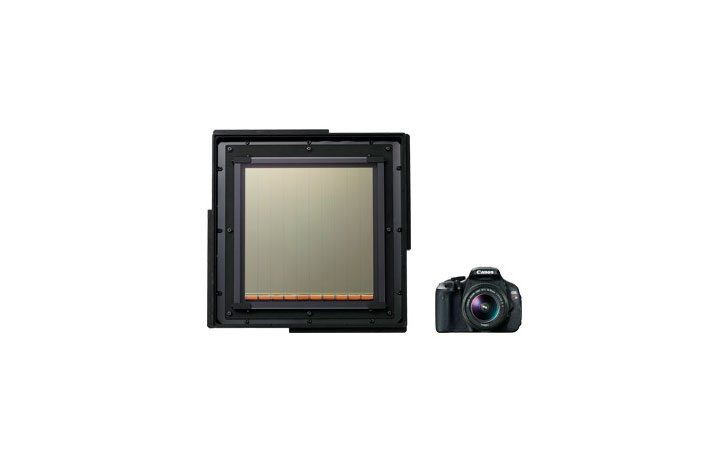Canon has posted an article about what they claim is “The World's Largest Ultrahigh-Sensitivity CMOS Image Sensor”. You can see by the image above that the sensor dwarfs the Canon EOS Rebel T3i (600D).
This large image sensor was announced back in 2010.
As noted by Canon News, this sensor has no real impact on modern sensor technology, but it does show Canon's ability to scale an image sensor up to a massive size.
From Canon Global:
A certain level of light is required when shooting with a digital camera or camcorder, and without it, images cannot be captured due to insufficient sensitivity.
In the pursuit of further improving the sensitivity of imaging elements, Canon has embraced the challenge of achieving higher levels of sensitivity and larger element sizes while maintaining high-speed readout performance, and has succeeded in developing the world's largest class of CMOS image sensor measuring approximately 20 cm square. At present, the standard diameter of the silicon wafers on which CMOS sensors are fabricated is 12 inches (approx. 30 cm). As such, a 20-cm-square sensor is the largest size that can be manufactured based on these dimensions, and is equivalent to nearly 40 times the size of a 35 mm full-frame CMOS sensor.
Increasing the size of CMOS sensors entails overcoming such problems as distortion and transmission delays for the electrical signals converted from light. To resolve these issues, Canon not only made use of a parallel processing circuit, but also exercised ingenuity with the transfer method itself. As a result, the sensor makes possible the shooting of video at 60 frames per second with only 0.3 lux of illumination (approximately the same level of brightness as that generated by a full moon).
Possible applications for this ultrahigh-sensitivity CMOS sensor include the video recording of celestial objects in the night sky, nocturnal animal behavior and auroras, and use in nightwatch cameras.
When installed in the 105 cm Schmidt camera at the Kiso Observatory operated by the University of Tokyo's Institute of Astronomy, the ultrahigh-sensitivity sensor made possible the world's first video recording of meteors with an equivalent apparent magnitude of 10, a level so dark that image capture had not been possible until now. As a result, the sensor provided proof that the frequency with which faint meteors occurred coincided with theoretical estimates to date. By supporting more detailed recording and statistical analysis of meteors, the technology could lead to an increased understanding of the influence that meteors may have exerted on the development of life on Earth. Read the full article

